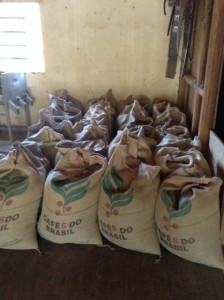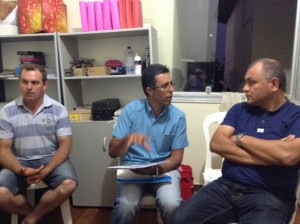Oscar Gonzales, Sustainable Harvest Quality Specialist, reports on his recent trip to Relationship Coffee suppliers in Brazil.
Earlier this month I took a trip to Minas Gerais, Brazil, to visit our supplier partners in the southern part of the state. Minas Gerais is one of the most important coffee regions in Brazil, producing nearly 20 million bags each year. This represents more than half of all the coffee cultivated in Brazil, which is the largest exporter of coffee in the world.
 Minas Gerais is known among Brazil’s coffee regions for its high-quality product, but this year was abnormally complicated for growers in the region. Namely, one of the worst droughts in a decade hit the area, sending C-market prices soaring as fears of production losses grew. Further complicating things, some areas were also hit with inclement weather and hail. When I spoke to the organizations this month, they said these factors contributed to a loss of 40% of production, or about 7 or 8 million bags of coffee.
Minas Gerais is known among Brazil’s coffee regions for its high-quality product, but this year was abnormally complicated for growers in the region. Namely, one of the worst droughts in a decade hit the area, sending C-market prices soaring as fears of production losses grew. Further complicating things, some areas were also hit with inclement weather and hail. When I spoke to the organizations this month, they said these factors contributed to a loss of 40% of production, or about 7 or 8 million bags of coffee.
The C market’s volatility put Brazil’s worrisome drought in the forefront of my mind as I arrived in Pocos de Caldas, located in southwestern Minas Gerais and my base camp for a week of visiting coffee farms throughout the region. We work with five cooperative organizations and two fazendas in the area, and in a country as vast as Brazil, I felt quite lucky that they are all within a couple hours of Pocos de Caldas by car.
 One of the highlights of the trip was a visit to the Assodantas cooperative, which has grown and matured so much under its inspiring general manager, Joao. With funds from its fair-trade premiums, the co-op bought land and is now equipped with a warehouse, processing plant, central offices, and a cupping lab. Members of Assodantas were not particularly hard hit by inclement weather this harvest, and as a result they are excited to supply us with some high-quality coffees this year.
One of the highlights of the trip was a visit to the Assodantas cooperative, which has grown and matured so much under its inspiring general manager, Joao. With funds from its fair-trade premiums, the co-op bought land and is now equipped with a warehouse, processing plant, central offices, and a cupping lab. Members of Assodantas were not particularly hard hit by inclement weather this harvest, and as a result they are excited to supply us with some high-quality coffees this year.
While visiting other cooperatives, I found a similar enthusiasm for this year’s harvest. While some of the groups are reporting complications due to the drought, all are certain that they can comply with their contracts and are excited for the harvest to get under way. They are working to recuperate and to export high-quality coffees that will generate prices that will keep them competitive in the coming years. I’ve returned to Peru excited that we will continue to strengthen our relationships with coffee growers throughout all of Brazil, bringing our customers the diverse array of coffee that the country has to offer.



.png)
